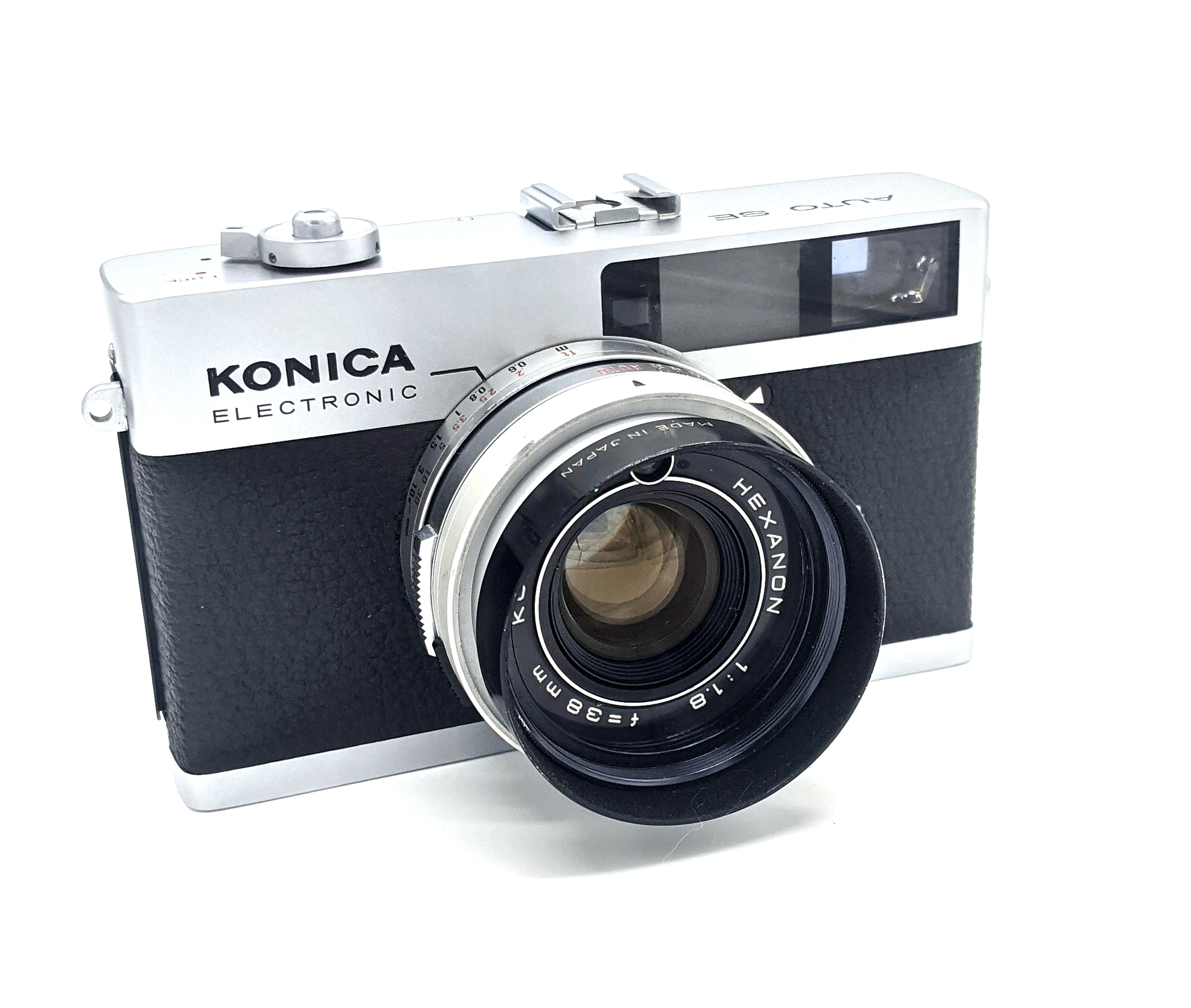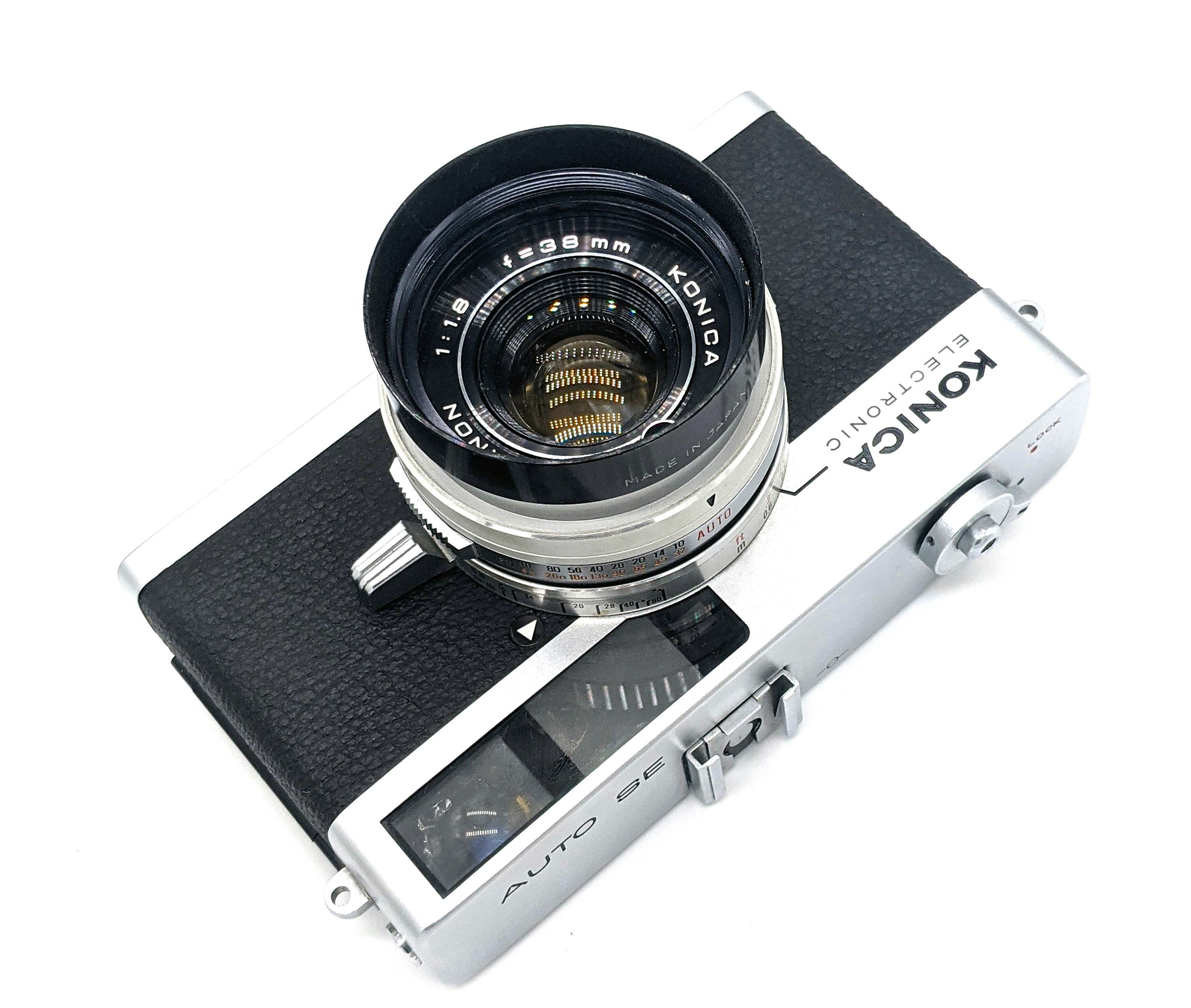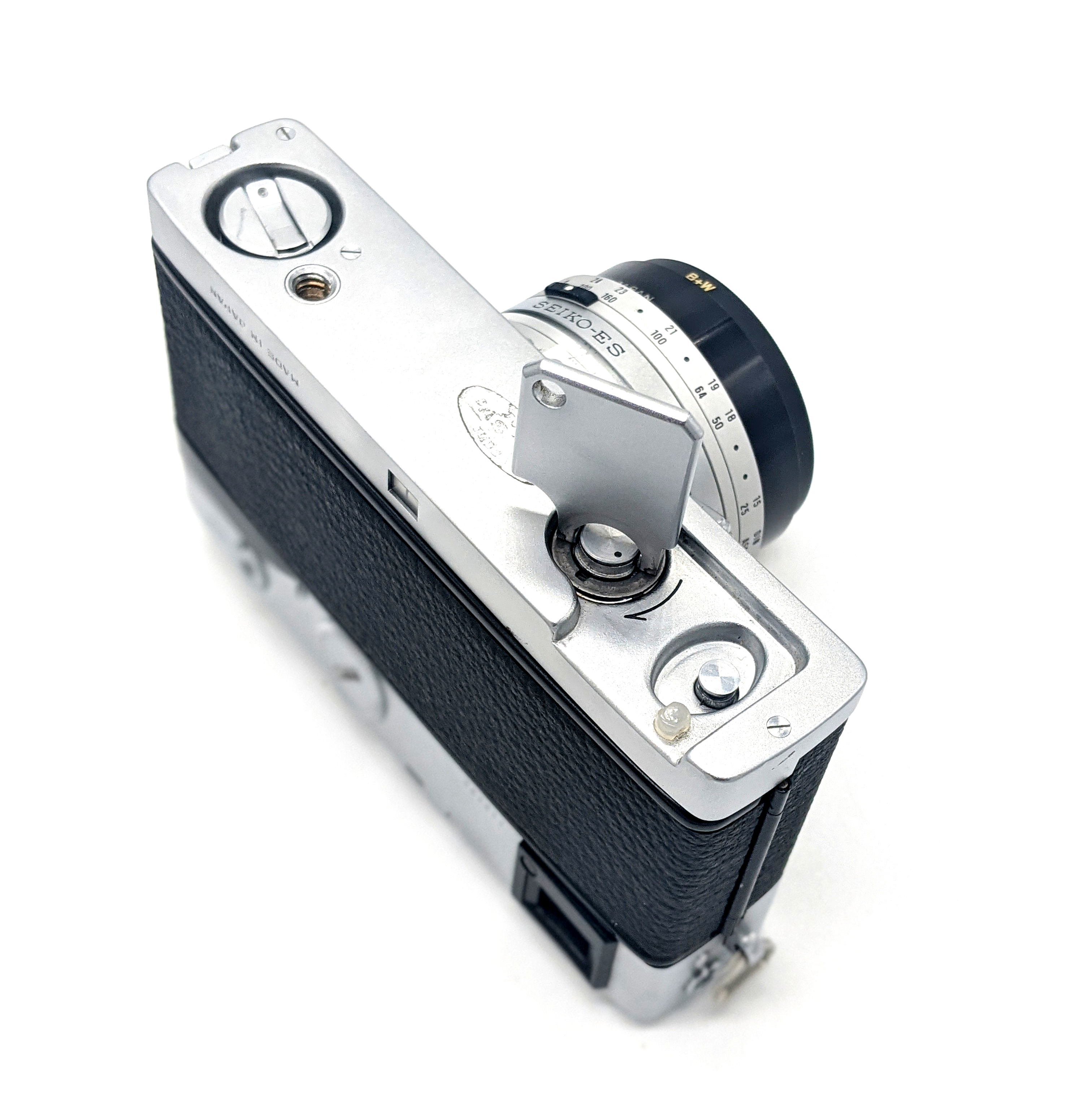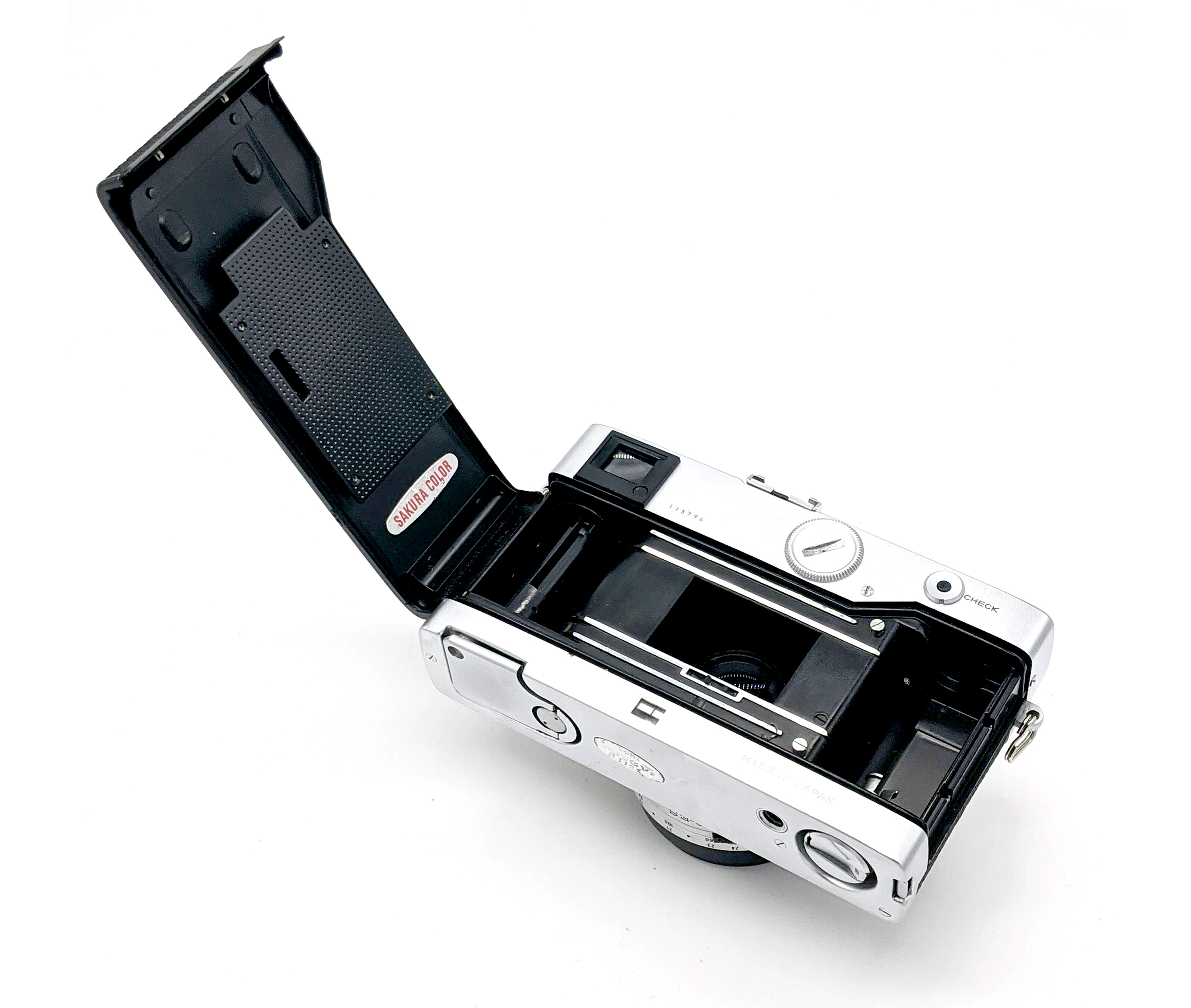
Announced in 1966, but not introduced to market until some time in 1967, the Konica Auto SE Electronic is a relatively-obscure, fixed-lens, spring-loaded auto-advance, program-mode-only 35mm rangefinder camera sandwiched between the well-known Auto S2 and followed in 1969 by the similarly-program-only Electron. The Auto SE was the first implementation of Konica’s four-group, six-element 38mm f/1.8 Hexanon lens, the second and final occasion being on the 1973-77 Auto S3. Not only can the Auto SE focus down to 0.6m, quite a feat, it also was one of the very few production 35mm rangefinder cameras that incorporated a wind-up, spring-loaded automatic film advance.
My working theory is that the Auto SE was part of a collaboration with Seiko, the famous clock and watch maker. The SE contains a Seiko-branded shutter, uses an odd-sized battery that is normally used in clocks, employs a spring-loaded advance very similar to wind up clocks, and lacks any of the viewfinder information normally found in the contemporary Auto S/S2 series of cameras.
The Auto SE was not cheap and cost about $100-130 in late 1960s dollars (like @ $800 today). Although it is not known exactly how long the Auto SE was produced, it was still being advertised for sale at least as late as 1970. Other than an exterior design resemblance, the Auto SE shares little in common with Auto S2. Being lucky enough to find one that “works,” let’s take a closer look at this yunikōn.
Specifications
| Lens | 38mm f/1.8 Hexanon |
| Shutter | Seiko ES |
| Parallax Correction | Yes |
| Viewfinder Magnification | 0.59x |
| Effective Rangefinder Baselength | 24.8mm |
| Shutter Speed Range | 1/15 – 1/500 |
| Aperture | f/1.8 – f/16 |
| X Sync | 1/30 |
| Minimum Focus | 0.6m |
| Meter | TTL CdS |
| Battery | PX1 / MR50 1.35V |
| ASA Range | 25-400 |
| Filter Size | 49mm |
| Weight | 750g |

Operation
Program Mode Autoexposure: The Auto SE operates in program mode only. Because the manual does not illuminate the preferences of the programming, all we know is that the camera will automatically set a shutter speed and aperture for a particular shot. The Auto SE will most likely default down to 1/30 at f/1.8 in insufficient lighting. The CdS cell on top of the lens should automatically compensate for any colored / neutral density filters. The shutter itself makes little noise, but the auto advance sure does.
The Lens: Perhaps the primary draw to the Auto SE for most camera enthusiasts would be Konica’s first implementation of its 38mm f/1.8 Hexanon lens. Although no official design schematic seems to exist for the Auto SE (or the Auto S3), we know that the Auto SE version is a single-coated, mostly symmetrical 1-2-2-1 double-gauss design. It is entirely possible that the 38mm is simply a modified version of the 45mm f/1.8 from the Auto S2. However, in an era where nearly all fixed-lens rangefinders cameras sported lenses in the 45-50mm focal length, a 38mm lens is much more versatile. More importantly, the lens itself could focus down to 0.6m, one of the only cameras in its class that could do so. While the Auto S3’s 1973 version of the 38mm was multicoated, it could only focus down to 0.9m. The Auto SE has a relatively short focus throw like the Auto S3.
Viewfinder/Rangefinder: The viewfinder is pleasant, is fairly demagnified, is automatically parallax-corrected, and has yellow projected framelines. It has the same blueish tint as the Auto S3 and is not super flare resistant. There is no exposure information in the viewfinder. The only light that appears is a very odd yellow “star” at the bottom as an underexposure warning / battery check. Although my example may have an unknown level of normal degradation, the square rangefinder patch is visible but of course will get somewhat washed out in direct light.
Battery Check: On the back of the camera is a “battery check” button. Pressing it will illuminate the same bizarre yellow star in the viewfinder that serves as the underexposure warning.
Lens Hood: Like other 1960s Konica rangefinder models, the Auto SE has a built-in, slide-out lens hood. The Auto SE also has a removable plastic filter holder that screws into the front of the lens, Because the lens hood does not have much travel, it will barely get past a 49mm filter. Any hood that exceeds the diameter of the lens itself will tend to block the rangefinder. Like the Auto S3, the screw-in hood from the Minolta 7sII or the hood from the early 1960s Konica Auto S will work, but good luck finding either.
Spring-Loaded Film Advance: The coolest design feature of the Auto SE is certainly the bottom fold-in key for spring-loading the film advance. The manual states that the system is good for 20 shots on a single full wind. Because the shutter is quiet and the drive is pretty loud, you can snap a photo, keep your finger on the shutter, and then walk away. The film release and rewind crank is also on the bottom of the camera.
Film Loading & Unloading: The Auto SE will not operate without film loaded and will not even fire the shutter. It is not quite clear how the camera knows there is no film loaded, but there must be some kind of communication between the winding mechanism and the shutter (perhaps to avoid double exposures?). The Auto SE loads film the opposite way than a traditional camera. Insert the film leader into the take-up and then use the key on the bottom to advance the film. Once you close the back, you fold out turn the key until it automatically switches over from “loading mode” to “winding mode.” Very cool. The film counter is bottom center below the film door. To unload the film, you have to pull out the key and hit the button underneath it, which will release all of the tension on the film advance to permit the rewinding of the film on the tucked-in knob on the opposite side of the base plate.
Self-Timer/Shutter Lock: Another interesting design feature of the Auto SE is the self-timer and shutter lock. The self-timer is activated by moving the switch around the shutter button down and then pressing the shutter activates it. You can also lock the shutter entirely by sliding the switch up.
Metering/Battery: The Auto SE appears to use the same CdS metering system as the Auto S2, which uses a single sensor placed above the lens. The Auto SE takes a single and unusual mercury PX1/MR50 1.35V battery, inserted on the back of the camera to the right of the viewfinder. Because PX1/MR50 batteries are no longer made, the available substitutes include modern 1.5V LR50/A1PX alkaline batteries. There is also a rather pricey MR50-sized step down converter to 1.35V, which I could not get to work at all with the Auto SE. As a side note, MR50s were most commonly used in desk clocks back in the day.
ASA Range: The Auto SE only permits ASA selection from 25 to 400 via a switch on the bottom of the lens.
Hot Shoe/Flash: The Auto SE may have been the first Konica camera product to come equipped with a hot shoe for a flash. For flash exposure, the Auto SE uses a “guide number” system, which essentially means that given the flash’s rated power in manual mode, the camera will automatically adjust the shutter speed and aperture automatically to account for both the focusing distance and available ambient light. After mounting an electronic flash, you have to turn the lens dial to the appropriate guide number on the lens and then take the photo. For instance, if you mount a flash with a guide number of 14 (GNs are usually for 100 ASA), put the flash on full power (not “auto mode”) and then turn the lens dial to “14.” While the Auto SE will default the X-sync flash speed to 1/30, the camera will set the appropriate aperture given the focused distance to the subject. The Auto S3’s concept is the same, but works a little differently. The Auto S2 had a more conventional flash system where with an electronic flash’s auto mode, you manually selected a shutter speed of 1/60 or below and the appropriate aperture.
Shutter: The Auto SE appears to be the only Konica fixed-lens rangefinder camera of the 1960s to use a Seikosha electronic shutter. Of course, Seikosha had supplied a variety of leaf shutters for Konica’s 1950s products, including the III series as well as many of the medium format folding Pearls. The only other popular 35mm rangefinder at the time to use the Seikosha ES shutter was the 1965 Canon QL19.
Construction/Size: Small and light may not be suitable adjectives for the Auto SE. What is striking about the Auto SE is how well it is made, sturdy, well-finished, and functional (but minimal) design. Regarding both design and ergonomics, the Auto SE is real winner.

Versus Contemporary Competitors
There is no other fixed-lens rangefinder camera that has the same combination of features as the Auto SE. While the SE may not have been “first-to-market” with many of its features, it remains unique in combining them. Although a spring-loaded drive could be found on the contemporary scale-focused half-frame Fuijca Drive and Canon Dial cameras as well as full-frame cameras like the Kodak Motormatic, the “Robot Royal,” and the obscure Soviet “Leningrad” rangefinder cameras, none were quite as advanced or shared a similar combination of features as the Auto SE. By 1966, a coupled fixed-lens rangefinder camera wider than 40mm could be found on a variety of cameras produced during the late 1950s and early 1960s, like the Ricoh Wide (35mm f/2.4) and Kowa Wide F (35mm f/2.8) but none had a built-in CdS meter or were as fast at f/1.8. During the 1960s, only a small handful of fixed-lens rangefinder models could focus down to 0.7m (the Auto S2 could only focus down to 0.9m), like the 1967 Fujica Compact Deluxe and the 1969 “New” Canon QL17. However, the “New” QL17 is not a good comparison because it was arguably part of the next generation of compacts. The 1965 QL19 would have been the comparable Canon product to the Auto SE.
Because there was no obvious direct “competitor” to the Auto SE, I would imagine the combination of the close-focusing wider lens, rangefinder coupling, and the “point-and-shoot” CdS autoexposure system would have been the main draws. By 1969, the next generation of camera products were starting hit the market that would have dethroned the Auto SE from any technological advantages it may have briefly enjoyed.

Versus Other Konica Rangefinders
| Auto S2 | Auto SE | Auto 1.6 | Electron | Auto S3 | |
| Year | 1965 | 1966 | 1967 | 1969 | 1973 |
| Lens | 45mm f/1.8 | 38mm f/1.8 | 45mm f/1.6 | 45mm f/1.8 | 38mm f/1.8 |
| Min. Focus | 0.9m | 0.6m | 1.00m | 0.9m | 0.9m |
| Shutter Speed Range | B – 1/500 | 1/15 – 1/500 | B – 1/500 | ? | B – 1/500 |
| Exposure | Shutter / Manual | Program | Shutter / Manual | Aperture | Shutter |
| Weight | 750g | 750g | 783g | ? | 410g |
| Film Advance | Lever | Spring | Lever | Lever | Lever |
| Filter Thread | 55mm | 49mm | 55mm? | ? | 49mm |
| Metering | CdS | CdS | CdS | Dual CdS | CdS |
| Parallax Correction | Yes | Yes | Yes | Yes | Etched |
| ASA Range | 25-400 | 25-400 | 25-400 | 25-400 | 25-800 |
| Shutter | Copal SVA | Seiko SE | Copal SVA | Copal | Copal Leaf |
| X Sync Speed | All | 1/30 | All | ? | All |
| Hot Shoe | No | Yes | Yes | No | Yes |
| VF Magnification | 0.65x | 0.59x | 0.65x? | ? | 0.55x |
| Original Battery | PX625 | PX1 / MR50 | PX625 | PX32 | PX675 |
Some Maintenance Tips
Adjusting Horizontal RF Alignment: Like many other 1960s Konica rangefinders, the horizontal rangefinder adjustment is a pretty “easy” task. On the plastic viewfinder piece on the back of the camera, you will see a small plastic screw cover with two tiny holes. With a pair of sharp-pointed tweezers, rotate that screw CCW and take it out. You will then expose a hole that will lead to the horizontal adjustment. Although you will not be able to see what you are doing, stick a small flathead screwdriver into the hole, find the groove in the screw, and turn it appropriately until the rangefinder is aligned.
Cleaning the Viewfinder: This is fairly straightforward. The top plate is held on by six screws — three tiny screws on the shutter lever and three around the top plate. Loosen but DO NOT REMOVE the three tiny screws on the shutter lever until you can lift the lever itself straight off. Then go onto the easier screws around the body. Be careful with the soldered wires to the top plate because those are very easy to break. The viewfinder windows are then very easy to get to.
Conclusion
While the iconic Auto S2 was and remains Konica’s premiere fixed-lens 1960s rangefinder, the more obscure Auto SE incorporates a variety of features that sets it apart. Despite having almost no ability to override its automatic exposure system, the Auto SE’s close-focusing wider lens, its automatic mechanical film advance, and its relatively-advanced flash system more than make up for it. The Auto SE makes an interesting case as a competitor to the Auto S3. Although both share the same lens, the Auto SE focuses significantly closer, has a larger viewfinder, has an automatic film advance, and does not constantly drain the battery by running the meter whenever the lens cap is removed. The Auto S3 on the other hand is smaller/lighter, has shutter-priority exposure control, and has an exposure lock. If you can live with program-only autoexposure, the Auto SE is a real winner in the 1960s fixed-lens rangefinder category in every other respect.
Manual
Because the Auto SE manual is not otherwise online anywhere, here it is for your reference.
Great and thorough review. Helped me decide to try out this special camera. Thanks!